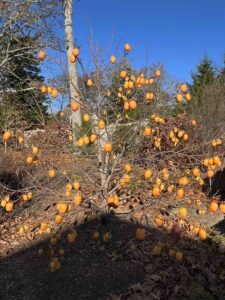by Louise Ayer
In our garden, which we affectionately call Ayerland, we try to grow a wide variety of plants, edible to all kinds of critters, including us. It is amazing the variety of plants we can grow on 2 ½ acres. We try to plant as many native plants as we can because that is what native critters like to eat; birds, insects, including bees, and animals. If you let them all flourish, including the insects, they create a happy, in balance ecosystem.
We find if we plant fruit that is native to the area, it does not get attacked by insects, and it seems to be much more prolific than non-natives. All the stone fruits like apples, peaches, plums, etc. do not do well on the Cape and are susceptible to nasty diseases such as cedar rust and leaf curl. We do not like to use chemicals at all and, since we don’t, these poor trees limp along. This year we are going to dig them up and give them to someone who lives off Cape, in an area where they will naturally thrive. What does do well are all different kinds of berries and persimmons.
Persimmons are native and thrive here. Our tree is still a baby, but we got a yield of over one hundred persimmons this year, even though the tree is only four years old. They are the last fruit of the year in anyone’s garden as they don’t even begin to ripen until all the leaves, which turn a beautiful orangey red in October, fall off. After the leaves are gone, the persimmons remain on the tree, hanging there like Christmas ornaments, and slowly beginning to ripen and turn sweet. We were picking ripe, luscious fruit in the middle of December! Can you believe it, the middle of December? What a treat! But beware, if you get impatient and pick them too early, they will suck all the moisture out of your mouth because they are very astringent at that stage of their maturity. So be patient and wait until they just begin to soften. Then, you can pick and leave them on your windowsill for a couple of days until they get quite soft. Then enjoy and fill your mouth with luscious sweetness. Don’t feel you have to grow a persimmon tree to try this treasure. They do appear in the supermarkets in November and December.

We ate lots of persimmons and shared them with family and friends. It was a novel experience for many of us, including me. They are very sweet and have a tropical fruit texture when ripe. They were lovely to eat for breakfast. My friend Priscilla was here during that time. She loves fruit with her breakfast and made sure she cut some up for all of us each morning. The last twenty or so we pureed and put in plastic bags and froze the puree flat like envelopes to be defrosted and made into muffins. We put four in a bag, which is the amount needed for a batch of muffins.
The texture of the muffins is similar to banana muffins, and we spiced them with cinnamon and ginger. I was very proud that we used every single one of these gifts from Mother Nature.
Persimmon Muffins
Makes 12 muffins
Ingredients:
3 teaspoons ghee for greasing muffin tin
1 cup all purpose flour
¾ cup sprouted spelt flour
2 teaspoons baking powder
1 tablespoon ground cinnamon
1 teaspoon ground ginger
4 ripe pureed Hachiya persimmons (see Cook’s Note)
½ cup coconut palm sugar
2 eggs
½ cup ghee, melted
Preheat oven to 400. Grease muffin tin with ghee. Whisk flour, baking powder, cinnamon, ginger, and sugar in a large bowl. In a medium bowl, whisk persimmon puree and eggs together. Pour the ghee into the egg mixture very slowly, whisking the whole time so as not to cook the eggs. Combine the wet ingredients with the dry. Fill the muffin tins ⅔ full. Bake for 15 minutes until golden brown. Cool on a wire rack for 10 minutes. Once cool, the muffins can be stored for four days in an airtight container.
Cook’s Note: You can puree the persimmons with their skin.

 Get access to the monthly Rehumanization Magazine featuring contributors from the front lines of this effort—those living on Death Row, residents of the largest women’s prison in the world, renowned ecologists, the food insecure, and veteran correctional officers alike.
Get access to the monthly Rehumanization Magazine featuring contributors from the front lines of this effort—those living on Death Row, residents of the largest women’s prison in the world, renowned ecologists, the food insecure, and veteran correctional officers alike.